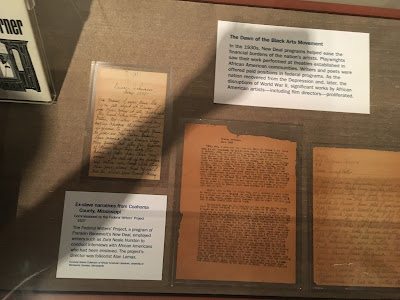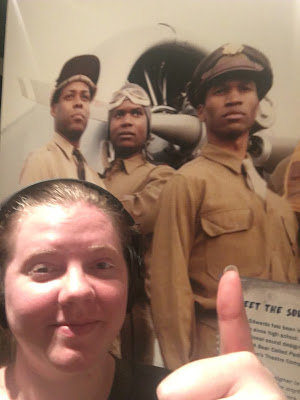You don't have to be a history buff to enjoy this stunning new exhibit.
 |
| Endless programs covering 40 years of theater. |
Sometimes you don't appreciate what you have until it's gone (or nearly so).
That was my main thought last Sunday as I strolled through the marvelous new exhibit celebrating the Penumbra Theater's 40 years of existence at the Minnesota Historical Society. This truly one-of-a-kind experience does a magnificent job of detailing what makes the Penumbra so special, the enduring legacy of their partnership with August Wilson, and the absolute tragedy that would have occurred had they shuttered for good over financial crises (as recently as five years ago, in fact).
 |
| Production design features were a favorite element of mine. |
There are two rooms featured in the exhibition. The first offers a history of the black arts movement (BAM) and Penumbra's quilt wall. Although I visited this room second, I would really recommend beginning with it - it offers a lot of context for the featured pieces on the Penumbra itself. This room has a varied mix of playbills, books, posters, performance photographs, and more that showcase some of the primary movers and shakers of the BAM. Among these are Langston Hughes, Amiri Baraka, James Baldwin, Lou Bellamy, and more.
 |
| Heart stopping features on African American history and the BAM. |
The second room features a solid focus on the Penumbra itself, with a wonderful sampling of highlights from past productions, interviews with core company members, and a marvelous focus on August Wilson's work. For cast interviews, you can sit before a "mirror" and play touching testimonies from company members such as James Craven, Abdul Salaam El Razzac, or Austene Van. Their stories are heartwarming and inspiring, ranging from juicy details of antics backstage to tear-inducing testimonies to the way that Penumbra's vibrant, diverse representation of black life has enriched their lives and careers. I highly recommend watching each video to hear the range of experiences.
 |
| The exhibit excels at showing the intersection of art, history, performance and legacy. |
Many productions are featured in special showcase here, with everything from video clips of performances to costume and set design close-ups to production photos and sound bites from sound technicians. It's not only a great look at the Penumbra's work itself, but also a testament to the legions of work inherent in creating any theatrical production. Any theater buffs, or novices who have never worked behind the scenes on a performance, will find a lot of interesting things to investigate here. Featured productions include Ma Rainey's Black Bottom; Black Angels (about the Tuskegee Airmen); The Ballad of Emmett Till; Dutchman and The Owl Answers; and, of course, the coup de grâce: Fences.
 |
| So awesome to see costumes close up where you can truly appreciate them. |
It's only appropriate that the first time an August Wilson piece is translated into an Oscar winning film occurs in the same year as this lovely tribute to his work. The Shakespeare of America (at least I am thoroughly convinced), August Wilson's Pittsburgh Cycle is one of the most genius explorations of life in America, and specifically black life, in existence today. The Penumbra has produced more of August Wilson's work than any theater in the world, and was in fact the first theater to stage one of his shows. Wilson's symbiotic relationship with the Penumbra (particularly Lou Bellamy, for whom he specifically crafted roles), is a fascinating subject and an excellent reminder that not all great work is created in an atmosphere of wealth or fame. In fact, I would go so far as to say that the best work, or at least the most important, is that which can truly reflect the lives of ordinary people and show how extraordinary seemingly quotidian events can actually be if we only change our perspective. No one does this better than Wilson, and I was riveted by the rich detail available in this exhibit.
 |
| Bow down and get close up to the original set and costumes for Fences. |
Wilson's magnum opus Fences receives terrific treatment in this exhibit. Fans can see the original set and costume pieces, marked up scripts from Bellamy and Wilson, video clips of past productions, and more. There are breakdowns of key elements of the show as well as strong connections to the rest of Wilson's work and the themes circulating throughout the Pittsburgh Cycle, culminating in a book of essays available on the subject. I was so happy to see this detail laid out and archived; I can only imagine what profound qualities to this relationship will be added in coming years.
 |
| Listening to detailed sound tech from the Black Angels. |
There are other cool features to this exhibit too. For kids, there is a series of coloring book sheets featuring past costume designs. An entire wall is filled with a copy of every program for each show the Penumbra has produced over the years, a glorious mosaic of graphic art excellence. A detailed history of the real Emmett Till primes readers for a richer understanding of the Penumbra's adaptation of that show. A guide to the art hanging in the Penumbra's halls, as well as the theater's importance to the neighborhood in which it resides, is also available and engaging.
 |
| Company member interviews were easily one of my favorite elements. |
This is the first museum exhibit I've seen that focuses on a specific theater for its subject, and it's absolutely worth a visit. It doesn't have to take a long time to walk through - you can breeze through in under an hour or spend hours if you prefer to really dive in to all the material available - and it's a fabulous reminder of the vibrant cultural history of the Twin Cities and a monument to the dedicated, often thankless work of the Penumbra company members. Without them we may very well have had fewer August Wilson plays; without them, generations of African Americans would not have had a safe, creative and diverse space in which to choose and rehearse roles outside of stereotypes in Minnesota. Without the Penumbra we would have no Black Nativity each holiday season, no summer arts camps specifically for African American students, no dynamic heart exploring the myriad ways one can be black in America. The gifts the Penumbra has given us are priceless indeed, and you need look no further than our own Minnesota Historical Society to see why. I hope they repeat this series with some of our other wonderful companies (such as Mu Performing Arts, Teatro del Pueblo or In The Heart of the Beast) and continue to remind us why the arts is more important than ever.
I highly encourage you to see this exhibit before it closes on July 30. For more information or to buy tickets, click on this link.

No comments:
Post a Comment